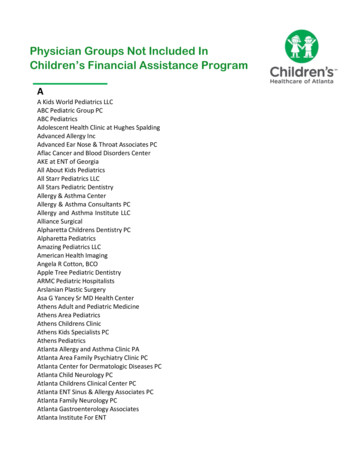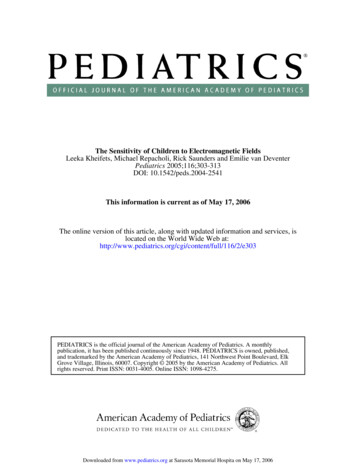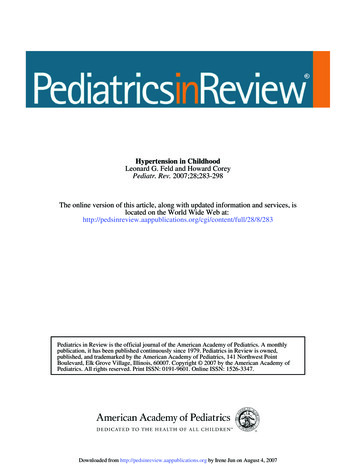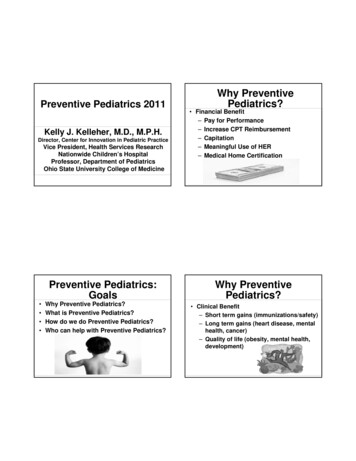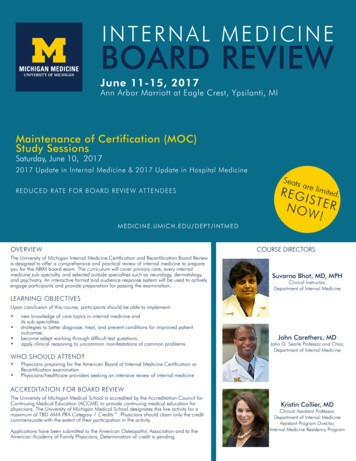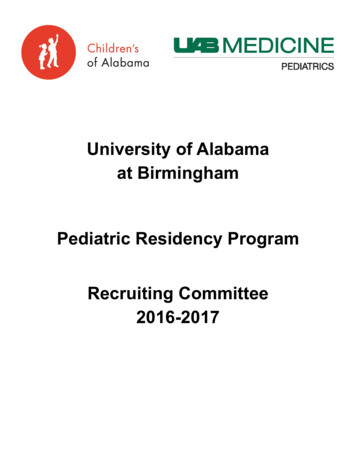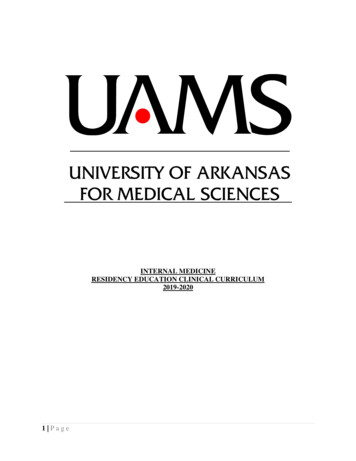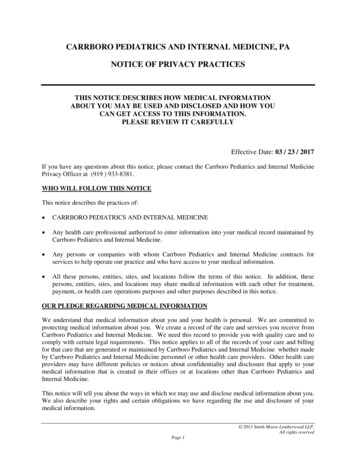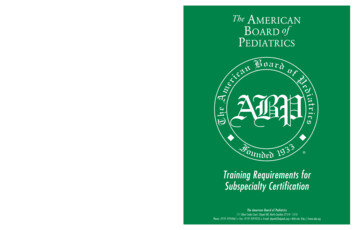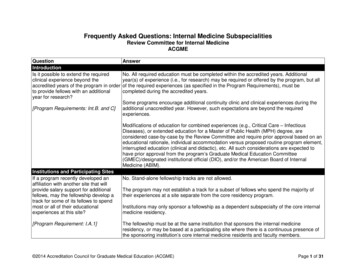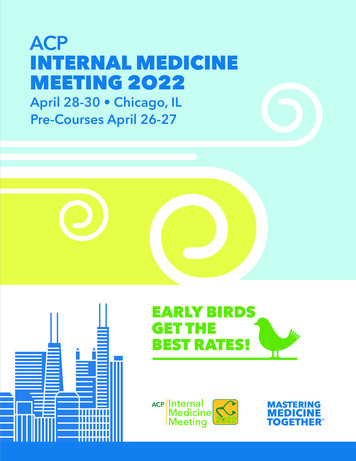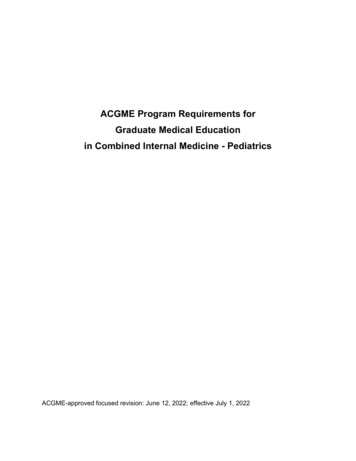
Transcription
ACGME Program Requirements forGraduate Medical Educationin Combined Internal Medicine - PediatricsACGME-approved focused revision: June 12, 2022; effective July 1, 2022
ContentsIntroduction . 3Int.A. Preamble . 3Int.B. Definition of Specialty . 3Int.C. Length of Educational Program . 4I. Oversight . 4I.A.Sponsoring Institution . 4I.B.Participating Sites . 4I.C.Recruitment . 6I.D.Resources . 6I.E.Other Learners and Other Care Providers . 8II. Personnel . 9II.A.Program Director . 9II.B.Faculty .14II.C.Program Coordinator .18II.D.Other Program Personnel .19III. Resident Appointments .19III.A.Eligibility Requirements .19III.B.Number of Residents .20III.C.Resident Transfers .21IV. Educational Program .21IV.A.Curriculum Components .21IV.B.ACGME Competencies.22IV.C.Curriculum Organization and Resident Experiences.30IV.D.Scholarship.39V. Evaluation.41V.A.Resident Evaluation .41V.B.Faculty Evaluation.46V.C.Program Evaluation and Improvement .47VI. The Learning and Working Environment .50VI.A.Patient Safety, Quality Improvement, Supervision, and Accountability atigue Mitigation.62VI.E.Clinical Responsibilities, Teamwork, and Transitions of Care.62VI.F.Clinical Experience and Education .63Internal Medicine-Pediatrics Tracked Changes Copy 2022 Accreditation Council for Graduate Medical Education (ACGME)Page 2 of 70
ACGME Program Requirements for Graduate Medical Educationin Internal Medicine-PediatricsCommon Program Requirements (Residency) are in BOLDWhere applicable, text in italics describes the underlying philosophy of the requirements in thatsection. These philosophic statements are not program requirements and are therefore notcitable.IntroductionInt.A.Graduate medical education is the crucial step of professionaldevelopment between medical school and autonomous clinical practice. Itis in this vital phase of the continuum of medical education that residentslearn to provide optimal patient care under the supervision of facultymembers who not only instruct, but serve as role models of excellence,compassion, professionalism, and scholarship.Graduate medical education transforms medical students into physicianscholars who care for the patient, family, and a diverse community; createand integrate new knowledge into practice; and educate future generationsof physicians to serve the public. Practice patterns established duringgraduate medical education persist many years later.Graduate medical education has as a core tenet the graded authority andresponsibility for patient care. The care of patients is undertaken withappropriate faculty supervision and conditional independence, allowingresidents to attain the knowledge, skills, attitudes, and empathy requiredfor autonomous practice. Graduate medical education develops physicianswho focus on excellence in delivery of safe, equitable, affordable, qualitycare; and the health of the populations they serve. Graduate medicaleducation values the strength that a diverse group of physicians brings tomedical care.Graduate medical education occurs in clinical settings that establish thefoundation for practice-based and lifelong learning. The professionaldevelopment of the physician, begun in medical school, continues throughfaculty modeling of the effacement of self-interest in a humanisticenvironment that emphasizes joy in curiosity, problem-solving, academicrigor, and discovery. This transformation is often physically, emotionally,and intellectually demanding and occurs in a variety of clinical learningenvironments committed to graduate medical education and the well-beingof patients, residents, fellows, faculty members, students, and all membersof the health care team.Int.B.Definition of SpecialtyResidency education in internal medicine-pediatrics encompasses integrativetraining in internal medicine and pediatrics. The combined training allowsdevelopment of a physician knowledgeable in the full spectrum of humandevelopment, from newborns to the aged. It includes the study and practice ofInternal Medicine-Pediatrics Tracked Changes Copy 2022 Accreditation Council for Graduate Medical Education (ACGME)Page 3 of 70
health promotion, disease prevention, diagnosis, care, and treatment of infants,children, adolescents, men, and women. The scientific model of problem solvingand evidence-based decision making with a commitment to lifelong learning andan attitude of caring derived from humanistic and professional values is integralto the specialty. The combined internal medicine-pediatrics program preparesgraduates to provide health care in a broad spectrum of practice that includesprimary and subspecialty care and ambulatory and hospital-based care, withadditional subspecialty training in urban, rural, and global settings.Int.C.Length of Educational ProgramThe educational program in internal medicine-pediatrics must be 48 months inlength. (Core)*I.OversightI.A.Sponsoring InstitutionThe Sponsoring Institution is the organization or entity that assumes theultimate financial and academic responsibility for a program of graduatemedical education, consistent with the ACGME Institutional Requirements.When the Sponsoring Institution is not a rotation site for the program, themost commonly utilized site of clinical activity for the program is theprimary clinical site.Background and Intent: Participating sites will reflect the health care needs of thecommunity and the educational needs of the residents. A wide variety of organizationsmay provide a robust educational experience and, thus, Sponsoring Institutions andparticipating sites may encompass inpatient and outpatient settings including, but notlimited to a university, a medical school, a teaching hospital, a nursing home, a schoolof public health, a health department, a public health agency, an organized health caredelivery system, a medical examiner’s office, an educational consortium, a teachinghealth center, a physician group practice, federally qualified health center, or aneducational foundation.I.A.1.I.B.The program must be sponsored by one ACGME-accreditedSponsoring Institution. (Core)Participating SitesA participating site is an organization providing educational experiences oreducational assignments/rotations for residents.I.B.1.I.B.1.a)I.B.1.a).(1)The program, with approval of its Sponsoring Institution, mustdesignate a primary clinical site. (Core)Relation to Categorical ResidenciesThe four-year combined training in internal medicine andpediatrics must be provided by ACGME-accreditedInternal Medicine-Pediatrics Tracked Changes Copy 2022 Accreditation Council for Graduate Medical Education (ACGME)Page 4 of 70
categorical programs in these specialties that aresponsored by the same ACGME-accredited SponsoringInstitution and are in close geographic proximity. (Core)I.B.1.a).(1).(a)The one exception is when the pediatrics programis sponsored by a children’s hospital, in which caseeither the designated institutional official (DIO) ofthe institution that sponsors the internal medicineresidency program or the DIO of the institution thatsponsors the pediatric residency program mayhave responsibility for oversight of the combinedprogram. (Core)I.B.1.a).(2)The categorical programs must each participate in onlyone internal medicine-pediatrics program. (Core)I.B.1.a).(3)The residents in the categorical and combined programsmust interact at all levels of training. (Core)I.B.1.a).(4)The program directors of the related categorical programsand the program director(s) of the combined program mustdemonstrate collaboration and coordination of curriculumand rotations. (Core)I.B.1.a).(4).(a)I.B.2.I.B.2.a)To achieve appropriate coordination of thecombined program and shared accountability,including integration of training and supervision ineach discipline, the program directors of thecategorical programs and the program director(s) ofthe combined program should hold at leastquarterly meetings that involve consultation withfaculty from both departments, as well as internalmedicine-pediatrics residents and/or residents fromboth departments. (Detail)†There must be a program letter of agreement (PLA) between theprogram and each participating site that governs the relationshipbetween the program and the participating site providing a requiredassignment. (Core)The PLA must:I.B.2.a).(1)be renewed at least every 10 years; and, (Core)I.B.2.a).(2)be approved by the designated institutional official(DIO). (Core)I.B.3.The program must monitor the clinical learning and workingenvironment at all participating sites. (Core)Internal Medicine-Pediatrics Tracked Changes Copy 2022 Accreditation Council for Graduate Medical Education (ACGME)Page 5 of 70
I.B.3.a)At each participating site there must be one faculty member,designated by the program director as the site director, whois accountable for resident education at that site, incollaboration with the program director. (Core)Background and Intent: While all residency programs must be sponsored by a singleACGME-accredited Sponsoring Institution, many programs will utilize other clinicalsettings to provide required or elective training experiences. At times it is appropriateto utilize community sites that are not owned by or affiliated with the SponsoringInstitution. Some of these sites may be remote for geographic, transportation, orcommunication issues. When utilizing such sites the program must ensure the qualityof the educational experience. The requirements under I.B.3. are intended to ensurethat this will be the case.Suggested elements to be considered in PLAs will be found in the ACGME ProgramDirector’s Guide to the Common Program Requirements. These include: Identifying the faculty members who will assume educational and supervisoryresponsibility for residents Specifying the responsibilities for teaching, supervision, and formal evaluationof residents Specifying the duration and content of the educational experience Stating the policies and procedures that will govern resident education duringthe assignmentSpecialty Background and Intent: If an internal medicine-pediatrics program uses a site thathas been approved for use by one of its sponsoring core programs, the internal medicinepediatrics program does not need a separate PLA for that site. PLAs are only needed for sitesthat are unique to the internal medicine-pediatrics program.I.B.4.I.C.The program director must submit any additions or deletions ofparticipating sites routinely providing an educational experience,required for all residents, of one month full time equivalent (FTE) ormore through the ACGME’s Accreditation Data System (ADS). (Core)The program, in partnership with its Sponsoring Institution, must engage inpractices that focus on mission-driven, ongoing, systematic recruitmentand retention of a diverse and inclusive workforce of residents, fellows (ifpresent), faculty members, senior administrative staff members, and otherrelevant members of its academic community. (Core)Background and Intent: It is expected that the Sponsoring Institution has, andprograms implement, policies and procedures related to recruitment and retention ofminorities underrepresented in medicine and medical leadership in accordance withthe Sponsoring Institution’s mission and aims. The program’s annual evaluation mustinclude an assessment of the program’s efforts to recruit and retain a diverseworkforce, as noted in V.C.1.c).(5).(c).I.D.ResourcesInternal Medicine-Pediatrics Tracked Changes Copy 2022 Accreditation Council for Graduate Medical Education (ACGME)Page 6 of 70
I.D.1.The program, in partnership with its Sponsoring Institution, mustensure the availability of adequate resources for resident education.(Core)I.D.1.a)The Sponsoring Institution must provide the broad range offacilities and clinical support services required to providecomprehensive care of the full spectrum of adult and pediatricpatients. (Core)I.D.1.b)Additional services should include those for cardiaccatheterization, bronchoscopy, gastrointestinal endoscopy, noninvasive cardiology studies, pulmonary function studies,hemodialysis, and imaging studies, including radionuclide,ultrasound, fluoroscopy, angiography, computerized tomography,and magnetic resonance imaging. (Detail)I.D.1.c)Adequate clinical and teaching space must be available, includingmeeting rooms, classrooms, examination rooms, computers,visual and other educational aids, medical and electronicresources to achieve all of the required educational outcomes,and office space for teaching staff. (Core)I.D.1.d)In addition to an emergency facility providing care for adults, theremust be an emergency facility that specializes in the care ofpediatric patients and that receives pediatric patients who havebeen transported via the Emergency Medical Services system.(Core)I.D.1.e)There should be services available from other health careprofessionals such as nurses, social workers, case managers,language interpreters, and dieticians. (Detail)I.D.1.f)Consultations from other clinical services should be available in atimely manner in all care settings where the residents work. Allconsultations should be performed by or under the supervision ofa qualified specialist. (Detail)I.D.1.g)The program should provide residents with access to trainingusing simulation. (Detail)I.D.1.h)The program must provide access to an electronic health record.In the absence of an existing electronic health record, institutionsmust demonstrate institutional commitment to its development,and progress towards its implementation. (Core)I.D.2.I.D.2.a)The program, in partnership with its Sponsoring Institution, mustensure healthy and safe learning and working environments thatpromote resident well-being and provide for: (Core)access to food while on duty; (Core)Internal Medicine-Pediatrics Tracked Changes Copy 2022 Accreditation Council for Graduate Medical Education (ACGME)Page 7 of 70
I.D.2.b)safe, quiet, clean, and private sleep/rest facilities availableand accessible for residents with proximity appropriate forsafe patient care; (Core)Background and Intent: Care of patients within a hospital or health system occurscontinually through the day and night. Such care requires that residents function attheir peak abilities, which requires the work environment to provide them with theability to meet their basic needs within proximity of their clinical responsibilities.Access to food and rest are examples of these basic needs, which must be met whileresidents are working. Residents should have access to refrigeration where food maybe stored. Food should be available when residents are required to be in the hospitalovernight. Rest facilities are necessary, even when overnight call is not required, toaccommodate the fatigued resident.I.D.2.c)clean and private facilities for lactation that have refrigerationcapabilities, with proximity appropriate for safe patient care;(Core)Background and Intent: Sites must provide private and clean locations where residentsmay lactate and store the milk within a refrigerator. These locations should be in closeproximity to clinical responsibilities. It would be helpful to have additional supportwithin these locations that may assist the resident with the continued care of patients,such as a computer and a phone. While space is important, the time required forlactation is also critical for the well-being of the resident and the resident's family, asoutlined in VI.C.1.d).(1).I.D.2.d)security and safety measures appropriate to the participatingsite; and, (Core)I.D.2.e)accommodations for residents with disabilities consistentwith the Sponsoring Institution’s policy. (Core)I.D.3.Residents must have ready access to specialty-specific and otherappropriate reference material in print or electronic format. Thismust include access to electronic medical literature databases withfull text capabilities. (Core)I.D.4.The program’s educational and clinical resources must be adequateto support the number of residents appointed to the program. (Core)I.D.4.a)I.E.The program must provide a volume, variety, and complexity indiagnoses and age, from infants to geriatric patients, sufficient forresidents to achieve all of the required educational outcomes. (Core)The presence of other learners and other care providers, including, but notlimited to, residents from other programs, subspecialty fellows, andadvanced practice providers, must enrich the appointed residents’education. (Core)Internal Medicine-Pediatrics Tracked Changes Copy 2022 Accreditation Council for Graduate Medical Education (ACGME)Page 8 of 70
I.E.1.The program must report circumstances when the presence of otherlearners has interfered with the residents’ education to the DIO andGraduate Medical Education Committee (GMEC). (Core)Background and Intent: The clinical learning environment has become increasinglycomplex and often includes care providers, students, and post-graduate residents andfellows from multiple disciplines. The presence of these practitioners and theirlearners enriches the learning environment. Programs have a responsibility to monitorthe learning environment to ensure that residents’ education is not compromised bythe presence of other providers and learners.II.PersonnelII.A.II.A.1.Program DirectorThere must be one faculty member appointed as program directorwith authority and accountability for the overall program, includingcompliance with all applicable program requirements. (Core)II.A.1.a)The Sponsoring Institution’s GMEC must approve a change inprogram director. (Core)II.A.1.b)Final approval of the program director resides with theReview Committee. (Core)Background and Intent: While the ACGME recognizes the value of input fromnumerous individuals in the management of a residency, a single individual must bedesignated as program director and have overall responsibility for the program. Theprogram director’s nomination is reviewed and approved by the GMEC. Final approvalof the program director resides with the applicable ACGME Review Committee.II.A.1.c)The program must demonstrate retention of the programdirector for a length of time adequate to maintain continuityof leadership and program stability. (Core)Background and Intent: The success of residency programs is generally enhanced bycontinuity in the program director position. The professional activities required of aprogram director are unique and complex and take time to master. All programs areencouraged to undertake succession planning to facilitate program stability whenthere is necessary turnover in the program director position.II.A.2.II.A.2.a)The program director and, as applicable, the program’s leadershipteam, must be provided with support adequate for administration ofthe program based upon its size and configuration. (Core)At a minimum, the program director must be provided with thededicated time and support specified below for administration ofthe program: (Core)Internal Medicine-Pediatrics Tracked Changes Copy 2022 Accreditation Council for Graduate Medical Education (ACGME)Page 9 of 70
Number of ApprovedResident Positions 77-10 10II.A.2.b)Minimum SupportRequired (FTE)0.20.40.5Programs with more than 15 residents must appoint an associateprogram director(s). The associate program director(s) must beprovided with support equal to a dedicated minimum time foradministration of the program as follows: (Core)Number of ApprovedResident Positions 65 65Minimum AggregateAPD SupportRequired -Specific Background and Intent: For instance, a program with an approvedcomplement of 24 residents is required to have 50 percent FTE support for the programdirector and 20 percent FTE support for the associate program director(s). The ReviewCommittee decided not to specify how the support should be distributed among associateprogram director(s) to allow programs, in partnership with their Sponsoring Institution, toallocate the support as they see fit.II.A.2.a)Additional salary support must be provided for an associateprogram directors(s) to devote non-clinical time to theadministration of the program as follows: (Core)Number of ApprovedResident Positions16-30 31Minimum AggregateAssociate ProgramDirector FTE salarysupport0.250.5Background and Intent: To achieve successful graduate medical education, individualsserving as education and administrative leaders of residency programs, as well asthose significantly engaged in the education, supervision, evaluation, and mentoring ofresidents, must have sufficient dedicated professional time to perform the vitalInternal Medicine-Pediatrics Tracked Changes Copy 2022 Accreditation Council for Graduate Medical Education (ACGME)Page 10 of 70
activities required to sustain an accredited program.The ultimate outcome of graduate medical education is excellence in residenteducation and patient care.The program director and, as applicable, the program leadership team, devote aportion of their professional effort to the oversight and management of the residencyprogram, as defined in II.A.4.-II.A.4.a).(16). Both provision of support for the timerequired for the leadership effort and flexibility regarding how this support is providedare important. Programs, in partnership with their Sponsoring Institutions, may providesupport for this time in a variety of ways. Examples of support may include, but are notlimited to, salary support, supplemental compensation, educational value units, orrelief of time from other professional duties.Program directors and, as applicable, members of the program leadership team, whoare new to the role may need to devote additional time to program oversight andmanagement initially as they learn and become proficient in administering theprogram. It is suggested that during this initial period the support described above beincreased as needed.In addition, it is important to remember that the dedicated time and supportrequirement for ACGME activities is a minimum, recognizing that, depending on theunique needs of the program, additional support may be warranted.II.A.3.II.A.3.a)Qualifications of the program director:must include specialty expertise and at least three years ofdocumented educational and/or administrative experience, orqualifications acceptable to the Review Committee; (Core)Background and Intent: Leading a program requires knowledge and skills that areestablished during residency and subsequently further developed. The time periodfrom completion of residency until assuming the role of program director allows theindividual to cultivate leadership abilities while becoming professionally established.The three-year period is intended for the individual's professional maturation.The broad allowance for educational and/or administrative experience recognizes thatstrong leaders arise through diverse pathways. These areas of expertise are importantwhen identifying and appointing a program director. The choice of a program directorshould be informed by the mission of the program and the needs of the community.In certain circumstances, the program and Sponsoring Institution may propose and theReview Committee may accept a candidate for program director who fulfills thesegoals but does not meet the three-year minimum.II.A.3.b)must include current certification in the specialty for whichthey are the program director by the American Board ofInternal Medicine (ABIM) or the American Osteopathic Board ofInternal Medicine, and the American Board of Pediatrics (ABP) orthe American Osteopathic Board of Pediatrics, or specialtyInternal Medicine-Pediatrics Tracked Changes Copy 2022 Accreditation Council for Graduate Medical Education (ACGME)Page 11 of 70
qualifications that are acceptable to the Review Committee;(Core)II.A.3.c)must include current medical licensure and appropriatemedical staff appointment; and, (Core)II.A.3.d)must include ongoing clinical activity. (Core)Background and Intent: A program director is a role model for faculty members andresidents. The program director must participate in clinical activity consistent with thespecialty. This activity will allow the program director to role model the CoreCompetencies for the faculty members and residents.II.A.4.Program Director ResponsibilitiesThe program director must have responsibility, authority, andaccountability for: administration and operations; teaching andscholarly activity; resident recruitment and selection, evaluation,and promotion of residents, and disciplinary action; supervision ofresidents; and resident education in the context of patient care. (Core)II.A.4.a)II.A.4.a).(1)The program director must:be a role model of professionalism; (Core)Background and Intent: The program director, as the leader of the program, mustserve as a role model to residents in addition to fulfilling the technical aspects of therole. As residents are expected to demonstrate compassion, integrity, and respect forothers, they must be able to look to the program director as an exemplar. It is ofutmost importance, therefore, that the program director model outstandingprofessionalism, high quality patient care, educational excellence, and a scholarlyapproach to work. The program director creates an environment where respectfuldiscussion is welcome, with the goal of continued improvement of the educationalexperience.II.A.4.a).(2)design and conduct the program in a fashionconsistent with the needs of the community, themission(s) of the Sponsoring Institution, and themission(s) of the program; (Core)Background and Intent: The mission of institutions participating in graduate medicaleducation is to improve the health of the public. Each community has health needs thatvary based upon location and demographics. Programs must understand the socialdeterminants of health of the populations they serve and incorporate them in thedesign and implementation of the program curriculum, with the ultimate goal ofaddressing these needs and health disparities.II.A.4.a).(3)administer and maintain a learning environmentconducive to educating the residents in each of theACGME Competency domains; (Core)Internal Medicine-Pediatrics Tracked Changes Copy 2022 Accreditation Council for Graduate Medical Education (ACGME)Page 12 of 70
Background and Intent: The program director may establish a leadership team toassist in the accomplishment of program goals. Residency programs can be highlycomplex. In a complex organization, the leader typically has the ability to delegateauthority to others, yet remains accountable. The leadership team may includephysician and non-physician personnel with varying levels of education, training, andexperience.II.A.4.a).(4)develop and oversee a process to evaluate candid
the institution that sponsors the internal medicine residency program or the DIO of the institution that sponsors the pediatric residency program may have responsibility for oversight of the combined program. (Core) I.B.1.a).(2) The categorical programs must each participate in only one internal medicine-pediatrics program. (Core)
